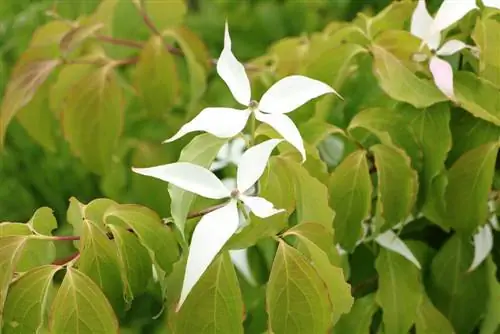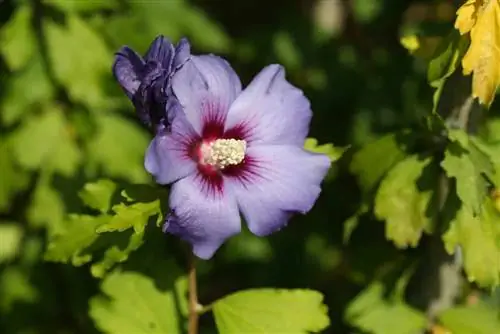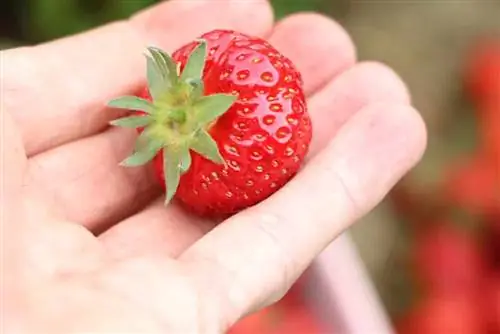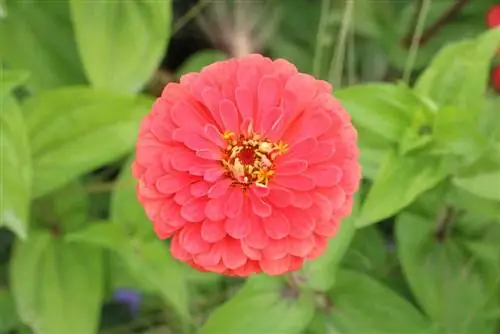- Author admin [email protected].
- Public 2023-12-17 03:39.
- Last modified 2025-01-24 12:45.
A gardening lover meets a fairy godmother and is allowed to wish for a tree. “It should definitely have decorative leaves. Beautiful flowers are a must. “Ah yes, a few unusual fruits would be great too,” he cheekily makes three wishes. Then the fairy smiles and conjures up a dogwood flower. She also has care instructions from A to Z and valuable tips.
Origin
Flower dogwood is the collective name for various types of dogwood. Cornus florida is native to North America. The Cornus kousa variety comes from East Asia, Japan and China. Numerous new cultivars have now emerged from these original species through cross-breeding. The huge flowers of the flower dogwood are the decisive difference to our native dogwood varieties. They bloom so profusely that you can hardly see anything of the rest of the bush during the flowering period.
Flowering and foliage coloring
The real flowers of the dogwood are small and inconspicuous. And because that's the case, the tree has come up with something to make these spherical inflorescences more attractive. He builds a false flower around each real flower, which cannot be overlooked even from a distance due to its color and size. Four transformed leaves, botanically known as bracts, glow white, pink or red instead of green from April to July, depending on the variety.
But the leaves of the flower dogwood master and love handling the paint pots so much that they use them again in the fall. The dogwood's foliage turns orange or red this time of year.
Chinese flower dogwood (Cornus kousa var. chinensis)
The Chinese flower dogwood grows to several meters high in good conditions and attracts everyone's attention even from a distance.
- grows almost 5 meters high in good conditions
- blooms bright white
- Flowering time is May to July
- develops fruits that are quite unusual to our eyes
- they are red, almost pink, look like a cherry
- Fruit skin is rather “pimply”, like raspberries
- Leaf dress changes color in autumn
Note:
The dogwood's cherry-like fruit is edible. However, it was unable to impress gourmets in this country with its taste. But as we all know, taste is a matter of taste and sometimes just a question of getting used to it.
Japanese flower dogwood (Cornus Kousa)
The Japanese flower dogwood is the most common in our gardens. It grows more upright and does not grow as wide as the Japanese dogwood.
- up to 6 meters in height
- short trunk, several upright main branches
- tiered crown structure
- blooms June to July
- white flowers, covered in a hint of pink
- the red fruits ripen in September
Popular varieties
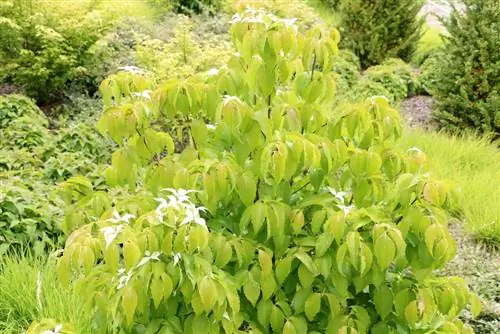
The colored flowers are the main feature of the flower dogwood and a decisive criterion. The shape of the flowers is usually similar, but the main difference is the color. The following Cornus kousa varieties delight with their color:
- 'Beni Fuji' blooms dark pink to red in June and July
- The 'Stellar Pink' hybrid offers pink flowers from May to June
- 'Milky Way' has cream-colored bracts and blooms May to June
- 'Satomi' has bracts in dark pink to light red, blooms May to June
- ‘China girl’ delights with reddish autumn leaves
- 'Butterfly' blooms soft pink at a young age.
- ‘Teutonia’ impresses with its large white-green flowers
Location
The flower dogwood thrives in a bright location with a portion of sun. Under no circumstances should it be exposed to the blazing sunlight from morning to evening. Therefore, look for a place in the garden that will give him some coolness during the day. Maybe there is a wall nearby that can provide him with shade for a few hours.
Depending on the variety, the flower dogwood can grow up to six meters in height and width. These Asian varieties form a beautiful crown. It has a tiered structure and is usually multi-stemmed. To do this, the tree needs enough space where it can develop unhindered in the desired direction. A location as a solitary plant also makes it appear even more eye-catching.
Floor
The soil in which the dogwood will thrive should be chosen carefully. If necessary, the existing floor structure needs to be optimized a little. The soil must be loose, well-drained and rich in humus. The soil should be moist, but not too moist. Excess water must be able to drain away easily. If this is not the case with the given soil, a drainage layer of gravel should be created before planting.
Asian flower dogwoods are, however, less demanding than other flower dogwoods; if necessary, they can also tolerate loamy and calcareous soil. For this reason, these flowering dogwoods are among the favorites of local garden owners.
Tip:
If there is a hilly area in the garden, it is an ideal location for the flower dogwood. Water drainage is much easier here.
Planting out
A young flower dogwood has to put its still tender roots into the “almost” unlimited freedom of the garden soil in spring. The coming warm days will provide them with enough warmth to develop well in their new environment. By autumn they reach a good level and can defy the winter. Where autumn proves to be a good planting time for other trees, it could be devastating for the flower dogwood. The young, freshly planted roots can be damaged by frost.
Bucket keeping
Flower dogwoods grow very slowly. They reach a height of 20 to 30 cm per year. That's why they can be kept well as container plants for several years. As a tree, they naturally need a sufficiently large container. This should be both deep and wide to provide enough space for root development. A bright location with moderate sun is ideal. In summer the bucket can be left outside. Compared to a flower dogwood planted in the garden, the flower dogwood in a pot requires a little more care.
- needs to be watered regularly
- needs protection in winter, the bucket has to go in
Propagation by seeds

Original varieties are propagated from seeds. If some of the red fruits are fertilized, a core develops inside them from which a new plant can sprout under optimal conditions. The cultivated forms are propagated through grafting, which, however, is far too demanding and time-consuming for hobby gardeners. It also requires that the small plant be cultivated in a greenhouse for a period of time. Very few people can offer these conditions.
If you have found one or more seeds in the red fruits, you can simply test your green thumb. Grow a few young plants from it in the house.
- Remove the core from the pulp
- Fill small flower pots with potting soil. Soil from the garden where the mother plant grows is also suitable.
- Plant the seed and water well.
- Give the pot a bright, partially shaded place on a windowsill.
- Keep the soil moist.
- If the small plant is around 20 cm tall, it can be put outside for a few hours every day, provided there is no threat of frost.
- You can plant the young flower dogwood from a height of 30 cm. But wait until spring.
Tip:
A young flowering dogwood does not have to be moved outdoors at the first opportunity. The bucket is a good home for him for the first few years of his life.
Reproduction by division
Shrub-shaped flower dogwood can be propagated by division. Dig up the shrub in spring and divide off the daughter plants. These are planted immediately after division. Their requirements for location, soil and care are identical to those of adult plants.
Cutting
With each newly developed branch, the flower dogwood becomes a little more beautiful. So why should you cut it? It doesn't go bald like some other trees. Although it tolerates pruning measures, regeneration is difficult for it. It should therefore only be cut if absolutely necessary. For example, if the crown has already grown very large and the available space is no longer sufficient orit already collides with neighboring plants. Exceptions may include some hybrid varieties where pruning can promote branching, even in older specimens.
- Pruning should be done after flowering
- sharp and clean secateurs/saw is a must.
- close larger cuts from around 2 cm in diameter with tree resin
If the cut is done after flowering in spring, the tree still has enough time to form new flower buds for the following year.
Pouring
The flower dogwood loves balanced conditions. It should not be too moist and not too dry, ideally slightly moist throughout. Since neither the rain nor the hours of sunshine are evenly distributed in our latitudes, balanced conditions will only prevail in parts. In summer, when the days are getting hotter and drier, you shouldn't use the garden hose to provide the necessary moisture.
Asian flower dogwoods tolerate lime, but rainwater suits them better. If necessary, watering should also be carried out daily. If you would like to avoid this routine activity, you can cover the soil area around the trunk with a layer of bark compost every year. This protects the top layer of soil from evaporation and keeps the root area cool. Ground cover plants also fulfill this purpose and also look attractive.
Tip:
Regular watering compacts the soil. Loosen this regularly. This is also a good opportunity to incorporate some fertilizer if necessary.
Fertilize
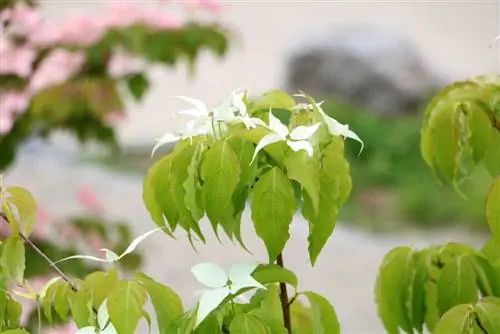
In its desired location, the flower dogwood is usually well supplied with nutrients and does not require any special attention. If the flower dogwood is also covered with a layer of mulch, it continuously draws on its nutrients. This consistent supply of nutrients in smaller doses is ideal for the flowering dogwood. Further fertilizer applications are then unnecessary.
If the flower dogwood is not covered with a layer of mulch, it may need some fertilizer every now and then. If growth retardation occurs, it's time to give it some fertilizer.
- fertilize as needed
- once a year is enough
- shortly before flowering is the right time
- natural fertilizer is ideal
- Compost and rotted manure work well
- Work fertilizer lightly into the top layer of soil.
Tip:
Better be economical when fertilizing. If there is a shortage, top-fertilization is possible at any time. An overdose, however, is more difficult to compensate for.
Diseases
Powdery mildew can occasionally occur, but it can be easily controlled. The plant survives this disease. Much worse is anthracnose, also known as leaf brown. It is a real threat to the flowering dogwood. The leaves have characteristic brown spots. Unfortunately, this disease cannot be combated well. The affected shoot tips should be removed as quickly as possible. If that doesn't help and the disease progresses, the entire tree must be disposed of before it dies. This means the disease has less time to infect other plants. Its diseased plant parts must not end up in the compost heap.
Accumulating moisture promotes the development of fungal diseases. In wet weather, the fungus can spread to the foliage and cause the entire tree to die. Prevent this by giving the flower dogwood the location it needs. If this is not available, planting is not recommended.
Pests
Brown shoot tips indicate leaf miners. The affected tips must be removed as quickly as possible. The shrub must also be treated with insecticides.
Mealybugs and mealybugs don't stop at the flower dogwood. However, they can be combated quickly and easily with simple means, such as a soft soap solution. Chemical remedies should only be considered if natural remedies are not sufficient.
Wintering
Flower dogwoods are available in stores that are hardy and can easily grow outdoors all year round. There is now such a large selection of these that varieties with lower winter hardiness can and should be avoided.
Flower dogwoods that are still kept in the pot are more sensitive to freezing temperatures. You should move to a frost-free, bright winter quarters before the first night frosts.

